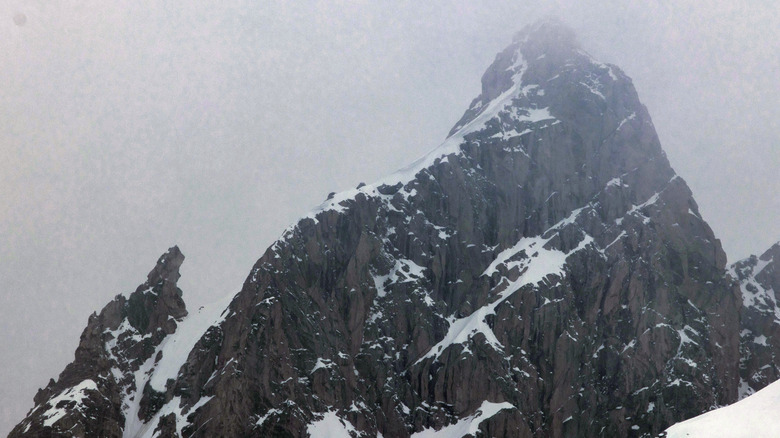Grand Teton National Park Rangers Warn Visitors To Look Out For This Dangerous Phenomenon
Grand Teton National Park in Jackson Hole, Wyoming, is a stunning example of natural wonder. From its steeply peaked mountains to the incredible fauna that live tucked between those slopes, it's a can't-miss destination that should be on everyone's bucket list. However, the park rangers of this beautiful national park are warning visitors to look out — or rather, look up — for a dangerous phenomenon: spontaneous rockfall events. Since early July 2025, several such events have taken place in the Tetons – the mountain range for which the park is named — altering the peaked landscape and endangering the lives of anyone in the area. Unfortunately, the events don't seem to be stopping, and it doesn't bode well for the Teton skyline.
The first event was observed over the 2025 4th of July weekend when a significant portion of a secondary peak on the Grand Teton, named the Second Tower, collapsed. The Jenny Lake Rangers, the park's elite search and rescue team, warned visitors on Instagram, "Heads Up! Multiple major spontaneous rockfall events have occurred," describing the collapse of parts of the Second Tower as well as a large boulder falling onto the winter trail up to the Lower Saddle. The rangers also reported a large debris field of rock visible from the valley on Teepe Glacier following intermittent events over the course of 48 hours on the Grand Teton. The main people affected by this activity are mountain climbers, who used to regularly scale Grand Teton's East Ridge.
What causes these rockfalls?
Speaking to Buckrail, geologist John Willott explained that the Grand Tetons are among the youngest of mountains in the continental U.S., and with it, there's still plenty of growing pains. Predominantly composed of granite, the peaks of the Tetons were formed from tectonic plate collisions, a process that involves quite a lot of heat and pressure.
As this process was concluding and the mountains surfaced, the temperatures gradually fell. The rock then hardened off, but not before a number of fissures formed. The fractures formed during this cooling-off period relieved pressure built up during formation, not dissimilar to cracking you see in house walls if the foundation isn't healthy.
These cracks and fractures have been visible on the Tetons for millennia, and they likely are the culprit behind the Second Tower's demise. The Jenny Lake Rangers explained that freezing and thawing cycles are likely to blame for rockfalls. As snow or rain falls and gets into the fissures of the mountain, it freezes during low temperatures, expanding the space between the rocks. When it melts, it then weakens the hold. This happens time and again until eventually collapse is imminent. Other weathering events, such as earthquakes or vegetation growth in the fractures, can also contribute to weakened rocks.
What can we expect in the future for the Grand Tetons?
This is not the first time the Tetons have experienced rockfall, nor will it be the last. The last round of significant rock collapse occurred in 2022 when other large parts of the Second Tower fell away, plummeting onto the East Ridge trail below. Unfortunately, reports of rockfalls are increasing, partially explained by warming temperatures due to climate change. Snow packs and glaciers are receding, year-round snowfields are melting, and more rock faces and debris that are normally held together by persistent ice and snow are becoming exposed.
Geologist John Willott explained to Buckrail that in geological terms, many mountain ranges degrade over time, particularly in these environmental conditions. For example, look at the Appalachian Mountains in the eastern U.S., of Appalachian Trail hiking fame. "If you think about the Appalachians back east, they were as tall as the Himalayas 350 million years ago," Willott said. "Now they are bumps in the road." Likely, the Tetons will continue to collapse "on a steady basis," Willott said, a theory corroborated by consistent rock collapse reports.
So what does this mean for visitors? Well, rangers are warning climbers to avoid the area, since rockfalls can be deadly to climbers. The route was popular prior to the 2022 collapse but has been treated with some level of trepidation since. Climbing guide Jed Porter spoke to WyoFile, reminding potential climbers that events like the Second Tower's collapse don't occur in isolation, but rather are indicative of future events that can still happen — big and small — over the course of the next few days, months, and years. Luckily, Grand Teton National Park has a number of incredible hikes, so there's plenty of opportunity to redirect your trip. Perhaps try out one of Grand Teton's lesser-known destinations to avoid crowds and avoid further stressing the mountain's landscape continuously in the same area.


